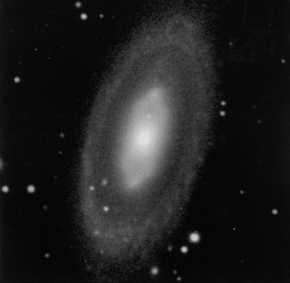
|



1. INTRODUCTION
Rings are an interesting aspect of galaxy structure. As shown by the example illustrated in Figure 1, the appearance of some otherwise normal galaxies is dominated by a ring of high contrast. In the jargon of normal galaxy morphology, there are three main types of observed optical ring phenomena: nuclear rings, inner rings, and outer rings. The rings can be very striking in appearance, as in Figure 1, or be merely part of the spiral pattern, which turns out to be the normal situation. Although rings appear to be a common aspect of galaxy morphology, as any casual inspection of one of several available atlases of galaxies will show, the features are hardly discussed at any length in introductory or graduate textbooks and are often treated as a mere ``detail'' of morphology. Yet, ringed galaxies are fundamentally interesting for a variety of reasons, not the least of which is the possible (and almost certain) association of the rings with dynamical orbit resonances. The purpose of this review is to summarize what is known about the features and the galaxies in which they are found, and in particular to try and bring together the large body of theoretical and observational results that are currently available. Since the vast majority of ringed galaxies are not violently interacting with other galaxies, it seems certain that rings are mainly a problem of internal dynamics. In fact, we believe rings may be a normal phase in the morphological evolution of many galaxies.

|
The structure of this review is as follows. First, we provide a historical review to help place the subject into a proper context, and to define the basic characteristics of the main ring types. Next, we present a thorough discussion of more recent observations of ringed galaxies from a variety of approaches: morphological, photometric, kinematic, and statistical. Then we discuss rings as resonances in barred galaxies, the role of gravitational torques on their formation, the influence of periodic orbits, and the use of N-body and test-particle simulations. After this, we consider the special problem of rings in nonbarred galaxies and how they might be related to spiral modes and resonances, and the possible dissolution of bars. Next, we will consider ring formation via mild tidal encounters as opposed to the more violent encounters that are believed to cause the polar ring galaxies and collisional ring galaxies. (These latter ring types are reviewed by Appleton and Struck-Marcell 1996.) Finally, we will discuss a few of the unusual examples which, though obviously barred, do not readily fit into the theoretical framework which we outline.